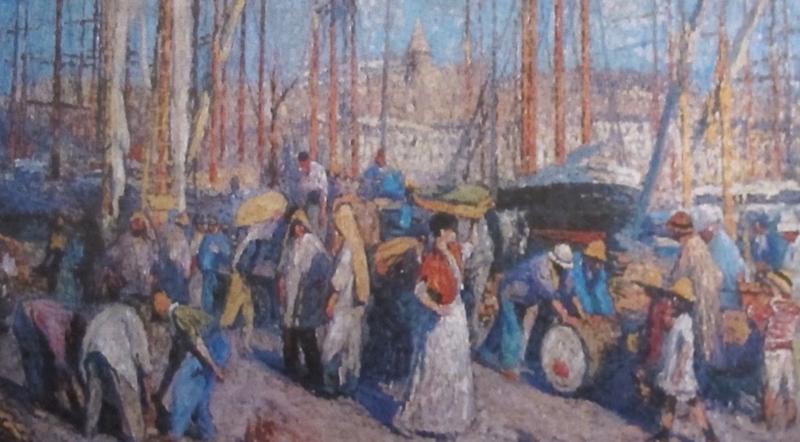Le Port de Marseilles

Henri Martin was born in Toulouse in 1860. He studied at the Ecole des Beaux-Arts and received a grant enabling him to go to Paris to continue his studies. In 1885 he travelled to Italy where he observed the Italian Renaissance masters which had a lasting and profound effect on his work. The work of Giotto, in particular, with his tranquil, light-filled landscapes, helped Martin to distance himself from his academic training and develop his own style which had affinities to Symbolism. By the 1890s he had moved towards a new way of painting clearly influenced by Neo-Impressionism. He painted numerous murals with a classical approach and influenced by Puvis de Chavannes but using the Pointillist technique.
Le Port de Marseilles is a precursor to Henri Martin’s much larger painting which was submitted for approval to the committee choosing the paintings for the principle salle at the French Supreme Court, the Conseil d’Etat, in the Palais Royal, Paris, opposite the Louvre. Martin was subsequently commissioned to paint four monumental panels illustrating the labours of France, ‘Agriculture’, ‘Commerce’, ‘Industry’ and ‘Intellectual’ work, to decorate the Hall of the General Assembly of the Council of State in June 1914. This was one of the most important and financially rewarding orders of Henri Martin’s long career.
Martin explained the concept of his paintings in 1916 to the Inspector of Fine Arts, Mr. Havard: “to symbolize work under all its forms, the first composition symbolizing the work of the spirit (‘Intellectual’ work) " and illustrates a solitary figure, the ‘thinker’, in a fir forest /sacred wood. He added that “on each side of the immense hall was to take place other more considerable compositions. The first symbolizes the work of the Earth by the representation of the various ways that it receives (‘Agriculture’). The second symbolizes the work of water by the sight of one of our sea ports (Bordeaux or Marseille)” (‘Commerce’). Finally, the fourth and last was called to symbolize industrial work (‘Industry’).
Le Port de Marseille is a precursor to Martin’s large mural painting symbolising ‘Commerce’. He employed broad brushstrokes to depict a group of people completely involved in their work. The idea of man in harmony with his surroundings, at ease in his environment and often at one with the cycle of nature is a theme that Martin often portrayed. He depicts the hustle-bustle of the busy port and yet gives it an ethereal, other-worldly feel. The rhythm of the repeated uprights of the boats’ masts convey the idea of a visual and physical continuation and connection between the workers in the foreground and the source of their work which we glimpse, hazily, through the masts. The figures take on the blue hues of the sea and the gold of the Mediterranean sunlight – the southern sun which Martin loved. The russet of the masts is linked to the woman’s shawl in the centre creating a prosody in the construction. Flecks of paint pull the colours together and the workers become almost abstract shapes of colour. The soft, dappled light and flickering blocks of shade and lighter colours creates an indistinct, almost dream-like harmony in a scene of a bustling port.
Martin, himself, felt at his most comfortable in a rural setting, producing his best works while he lived at his country estate, Marquayrol, overlooking La Bastide du Vert, near Cahors which he bought in 1900. The house, his family and the beautiful landscape provided him with inspiration for the rest of his life. Martin sought to convey the colours and textures of the changing seasons and the ancient rhythm of the agricultural world. He was a shy, quiet, independent character, who won praise and medals at the Paris Salon and became a member of the Legion of Honour.



